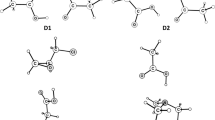Abstract
Results are summarized from a systematic study of the enthalpy–entropy compensation effect in non-catalytic and pyridine-catalyzed reactions of aryloxiranes with organic acids of various classes. This effect is observed in isoparametric (isokinetic, isoenergetic) reaction series, due to the interaction (nonadditivity) of the joint effects of temperature and structure. Experimental evidence of its physical reality in a number of cross reaction series is considered. In the context of the compensation effect, there are transitions from one state of reaction systems in which the enthalpy term of the free activation energy acquires a zero value (∆H≠ = 0, ∆G≠ = −TΔS≠) to another in which the contribution to the free energy of activation of the entropy term disappears (ΔS≠ = 0, ∆G≠ = ΔH≠). The character of activation processes when there is no enthalpy–entropy compensation is discussed.






Similar content being viewed by others
REFERENCES
P. R. Wells, Chem. Rev. 63, 171 (1963). https://doi.org/10.1021/cr60222a005
N. Chapman and J. Shorter, Advances in Linear Free Energy Relationships (Plenum, New York, 1972). https://doi.org/10.1007/978-1-4615-8660-9
C. D. Johnson, The Hammett Equation, Cambridge Texts in Chemistry and Biochemistry (Cambridge Univ. Press, Cambridge, 1980).
V. A. Pal’m, Fundamentals of the Quantitative Theory of Organic Reactions (Khimiya, Leningrad, 1977) [in Russian].
N. B. Chapman and J. Shorter, Correlation Analysis: Recent Advances (Plenum, New York, 1978). https://doi.org/10.1007/978-1-4615-8831-3
J. Shorter, Correlation Analysis of Organic Reactivity, with Particular Reference to Multiple Regression (Wiley, Somerset, NJ, 1982).
C. Reinhardt, Solvents and Solvents Effects in Organic Chemistry (Wiley-VCH, Weinheim, 2003).
A. Williams, Free Energy Relationships in Organic and Bioorganic Chemistry (RSC, Cambridge, 2003). https://doi.org/10.1039/9781847550927
V. A. Pal’m and B. I. Istomin, Reakts. Spos. Org. Soedin. 6, 427 (1969).
I. V. Shpanko, S. I. Kim, H. J. Koh, and I. Lee, Bull. Korean Chem. Soc. 16, 533 (1995).
I. V. Shpan’ko, Theor. Exp. Chem. 35, 63 (1999).
I. V. Shpan’ko, Theor. Exp. Chem. 37, 265 (2001).
J. E. Leffler and E. Grunwald, Rates and Equilibrium of Organic Reactions (Wiley, New York, 1963).
O. Exner, Prog. Phys. Org. Chem. 10, 411 (1973).
L. Liu and Q.-X. Guo, Chem. Rev. 101, 673 (2001). https://doi.org/10.1021/cr990416z
K. Sharp, Protein Sci. 10, 661 (2001). https://doi.org/10.1110/ps.37801
J. Norwisz and T. J. Musielak, Therm. Anal. Calorim. 88, 751 (2007). https://doi.org/10.1007/s10973-006-8139-4
P. J. Barrie, Phys. Chem. Chem. Phys. 14, 327 (2012). https://doi.org/10.1039/c1cp22667c
A. Cornish-Bowden, J. Biosci. 42, 665 (2017). https://doi.org/10.1007/s12038-017-9719-0
A. Mianowski, T. Radko, and T. Siudyga, React. Kinet. Mech. Catal. 132, 37 (2021). https://doi.org/10.1007/s11144-020-01898-2
V. N. Sapunov, E. A. Saveljev, M. S. Voronov, M. Valtiner, and W. Linert, Thermo 1, 45 (2021). https://doi.org/10.3390/thermo1010004
G. F. Dvorko, N. E. Ponomarev, and E. A. Ponomareva, Russ. J. Gen. Chem. 80, 1 (2010). https://doi.org/10.1134/S1070363210010019
I. V. Shpan’ko, I. V. Sadovaya, and A. M. Kitai-gorodskii, Theor. Exp. Chem. 36, 338 (2000). https://doi.org/10.1023/A:1005272628953
I. V. Shpan’ko and I. V. Sadovaya, Theor. Exp. Chem. 46, 176 (2010). https://doi.org/10.1007/s11237-010-9136-z
I. V. Shpan’ko and I. V. Sadovaya, Russ. J. Phys. Chem. A 90, 2332 (2016). https://doi.org/10.1134/S0036024416120268
I. V. Shpan’ko and I. V. Sadovaya, Russ. J. Gen. Chem. 87, 2552 (2017). https://doi.org/10.1134/S107036321711007X
I. V. Shpan’ko and I. V. Sadovaya, React. Kinet. Mech. Catal. 123, 473 (2018). https://doi.org/10.1007/s11144-017-1340-6
I. V. Shpan’ko, I. V. Sadovaya, and A. M. Kitai-gorodskii, Ukr. Khim. Zh. 69 (6), 111 (2003).
I. V. Shpan’ko and I. V. Sadovaya, Russ. J. Org. Chem. 41, 989 (2005).
I. V. Shpan’ko and I. V. Sadovaya, Ukr. Khim. Zh. 70 (4), 104 (2004).
I. V. Shpan’ko and I. V. Sadovaya, Ukr. Khim. Zh. 81 (10), 124 (2015).
I. V. Shpan’ko and I. V. Sadovaya, Kinet. Catal. 55, 56 (2014). https://doi.org/10.1134/S002315841401011X
I. V. Shpanko and I. V. Sadovaya, Russ. J. Gen. Chem. 89, 2358 (2019). https://doi.org/10.1134/S1070363219120053
I. V. Shpan’ko and I. V. Sadovaya, Russ. J. Phys. Chem. A 87, 1955 (2013). https://doi.org/10.1134/S0036024413120224
I. V. Shpan’ko, I. V. Sadovaya, and N. V. Kulikova, Russ. J. Org. Chem. 47, 687 (2011). https://doi.org/10.1134/S107042801105006X
Author information
Authors and Affiliations
Corresponding author
Ethics declarations
The authors declare they have no conflict of interests.
Additional information
Translated by A. Bulaev
Rights and permissions
About this article
Cite this article
Shpanko, I.V., Sadovaya, I.V. Enthalpy–Entropy Compensation in Reactions of Oxirane Ring Opening. Russ. J. Phys. Chem. 96, 2307–2317 (2022). https://doi.org/10.1134/S0036024422110309
Received:
Revised:
Accepted:
Published:
Issue Date:
DOI: https://doi.org/10.1134/S0036024422110309




